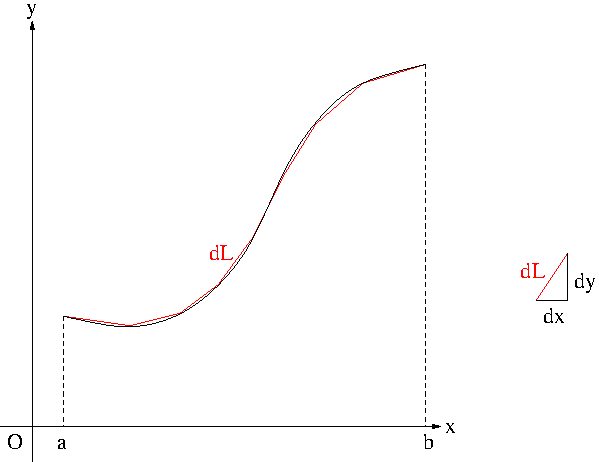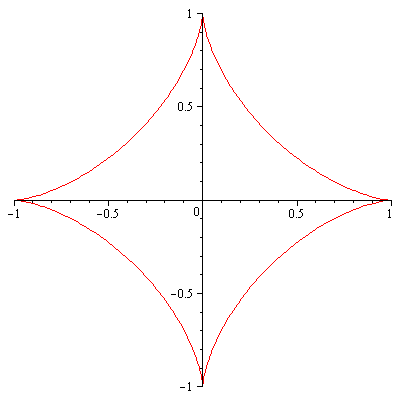Suppose that $y=f(x)$ is continuously differentiable on $[a,b]$.

Figure 1
Figure 1 shows the curve $y=f(x)$ is approximated by a PL (Piecewise Linear) curve (in red). Suppose that the line segments of the PL curve are infinitesimal and denote by $dL$ a line element. Then it is given by \begin{align*}dL&=\sqrt{(dx)^2+(dy)^2}\\&=\sqrt{1+\left(\frac{dy}{dx}\right)^2}dx\\&=\sqrt{1+[f'(x)]^2}dx\end{align*} Hence the length of the curve $y=f(x)$, $a\leq x\leq b$ is \begin{equation}\label{eq:arclength}L=\int_{x=a}^{x=b}dL=\int_a^b\sqrt{1+[f'(x)]^2}dx\end{equation}
Often a curve is represented by a parametric equation $r(t)=(x(t),y(t))$, $\alpha\leq t\leq\beta$ such that $x(t)$ and $y(t)$ are continuously differentiable. Such a curve is called smooth. A typical example is a motion in the plane (or in space). For a smooth curve $r(t)=(x(t),y(t))$, $\alpha\leq t\leq\beta$, $dL$ is \begin{align*}dL&=\sqrt{(dx)^2+(dy)^2}\\&=\sqrt{\left(\frac{dx}{dt}\right)^2+\left(\frac{dy}{dt}\right)^2}dt\end{align*} and hence \begin{equation}\label{eq:arclength2}\int_\alpha^\beta\sqrt{\left(\frac{dx}{dt}\right)^2+\left(\frac{dy}{dt}\right)^2}dt\end{equation} If $r(t)$ is the motion of a particle, $\left|\frac{dr(t)}{dt}\right|=\sqrt{\left(\frac{dx}{dt}\right)^2+\left(\frac{dy}{dt}\right)^2}$ is the speed of the particle and so \eqref{eq:arclength2} represents the distance traveled by the particle over the time interval $\alpha\leq t\leq\beta$.
Example (The circumference of a circle). Find the length of the circle of radius $r$.
Solution. The equation of the upper semicircle of radius r centered at the origin is $y=\sqrt{r^2-x^2}$, $-r\leq x\leq r$. $\frac{dy}{dx}=-\frac{x}{\sqrt{r^2-x^2}}$ and so the circumference is \begin{align*}2\int_{-r}^r\sqrt{1+\left(\frac{dy}{dx}\right)^2}dx&=2\int_{-r}^r\frac{r}{\sqrt{r^2-x^2}}dx\\&=4\int_0^r\frac{r}{\sqrt{r^2-x^2}}dx\\&=4\int_0^r\frac{1}{\sqrt{1-\left(\frac{x}{r}\right)^2}}dx\\&=4r\int_0^1\frac{1}{\sqrt{1-u^2}}du\\&=4r[\sin^{-1}(u)]_0^1\\&=4r\left(\frac{\pi}{2}\right)=2\pi r\end{align*}
The circle $x^2+y^2=r^2$ of radius $r$ centered at the origin can be described by the parametric equations $$x=r\cos t,\ y=r\sin t,\ 0\leq t\leq 2\pi$$ $\frac{dx}{dt}=-r\sin t$ and $\frac{dy}{dt}=r\cos t$ so $\sqrt{\left(\frac{dx}{dt}\right)^2+\left(\frac{dy}{dt}\right)^2}=r$. Therefore the circumference is $\int_0^{2\pi}rdt=2\pi r$. we find that using parametric equations of the circle comes with a much simpler calculation.
Example. Find the length of the asteroid $$x^{\frac{2}{3}}+y^{\frac{2}{3}}=1$$
Solution. The name asteroid is due to its graph as seen in Figure 2.

Figure 2. Asteroid
The asteroid can be parametrized as $$x=\cos^3 t,\ y=\sin^3 t,\ 0\leq t\leq 2\pi$$ $\frac{dx}{dt}=-3\cos^2 t\sin t$ and $\frac{dy}{dt}=3\sin^2 t\cos t$ so $\left(\frac{dx}{dt}\right)^2+\left(\frac{dy}{dt}\right)^2=9\cos^2t\sin^2t$. For $0\leq t\leq\frac{\pi}{2}$, $\sin t\geq 0$ and $\cos t\geq 0$. Hence \begin{align*}L&=4\int_0^{\frac{\pi}{2}}\sqrt{9\cos^2t\sin^2t}dt\\&=12\int_0^{\frac{\pi}{2}}\cos t\sin tdt\\&=6\int_0^{\frac{\pi}{2}}\sin 2tdt\\&=3[-\cos 2t]_0^{\frac{\pi}{2}}=6\end{align*} The integral $\int_0^{\frac{\pi}{2}}\cos t\sin tdt$ also can be done using a substitution. Let $u=\sin t$. Then $du=\cos tdt$ so \begin{align*}\int_0^{\frac{\pi}{2}}\cos t\sin tdt&=\int_0^1udu\\&=\frac{1}{2}\end{align*}
Example. Find the length of the curve $$y=\frac{4\sqrt{2}}{3}x^{\frac{3}{2}}-1,\ 0\leq x\leq 1$$
Solution. $\frac{dy}{dx}=2\sqrt{2x}$ so $\sqrt{1+\left(\frac{dy}{dx}\right)^2}=\sqrt{1+8x}$ and \begin{align*}L&=\int_0^1\sqrt{1+8x}dx\\&=\frac{2}{3}\cdot\frac{1}{8}[(1+8x)^{\frac{3}{2}}]_0^1\\&=\frac{13}{6}\end{align*}
Example. Find the length of the curve $y=\left(\frac{x}{2}\right)^{\frac{2}{3}}$, $0\leq x\leq 2$.
Solution. $\frac{dy}{dx}=\frac{1}{3}\left(\frac{2}{x}\right)^{\frac{1}{3}}$. Note that this derivative does not exist at $x=0$. Rewrite the function as $x=2y^{\frac{3}{2}}$, $0\leq y\leq 1$. $\frac{dx}{dy}=3\sqrt{y}$ and \begin{align*}L&=\int_{y=0}^{y=1}dL\\&=\int_{y=0}^{y=1}\sqrt{(dx)^2+(dy)^2}\\&=\int_0^1\sqrt{\left(\frac{dx}{dy}\right)^2+1}dy\\&=\int_0^1\sqrt{9y+1}dy\\&=\frac{1}{9}\cdot\frac{2}{3}[(9y+1)^{\frac{3}{2}}]_0^1\\&=\frac{2}{27}(10\sqrt{10}-1)\end{align*}
